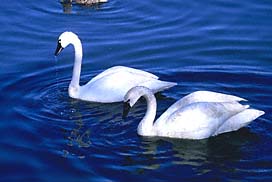Duck-like Birds
Description
48-55" (1.2-1.4 m). The most common swan in the West and the only native swan in the East. Large, all white; bill black, usually with small yellow spot in front of eye. Rare Trumpeter Swan is larger and lacks yellow on bill. Holds neck straight up, unlike Mute Swan, which bends its neck in a graceful curve.
Voice
Mellow bugling call, hoo-ho-hoo, usually heard from a flock of migrating birds.
Habitat
Arctic tundra; winters on marshy lakes and bays.
Nesting
4-6 creamy-white eggs placed on a large mound of grass and moss on an island or beside a marshy tundra lake.
Range
Breeds in Alaska and far northern Canada east to Baffin Island. Winters from southern Alaska south to Nevada, Utah, and Baja California and on mid-Atlantic Coast; rare on Gulf Coast of Texas; occasional on Great Lakes.
Discussion
Because they breed in remote and little disturbed areas, Tundra Swans have so far escaped the fate of the closely related Trumpeter Swan (Cygnus buccinator) of the West, which was reduced to near extinction by hunting and habitat destruction. In one study, Tundra Swans were marked with colored neck bands at Chesapeake Bay in Maryland, and their migration was followed to their Alaska breeding grounds. One bird, banded on the Atlantic Coast the previous winter, was sighted in the Central Valley of California in the following March. This Arctic breeder alternately visited the Atlantic and Pacific coasts of the huge North American continent, surely something of a record for birds.


